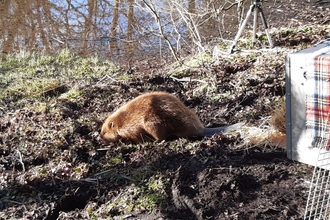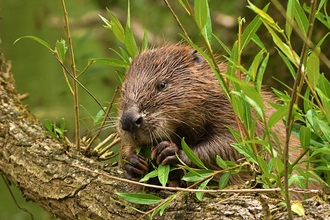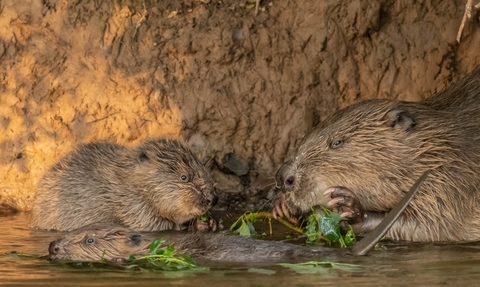
Jo Hackman Photography
Beaver updates
Beavers are known for their accolades as ecosystem engineers. But do you know the key features that make a beaver so well suited to its job and how they actually transform the environment around them to benefit other species?
Over the coming months, we will be highlighting the beaver adaptations that make them so well suited to their watery environment, and allow them to carry out their great engineering feats. We will also be sharing an exclusive glimpse into the Dorset Beaver Project site as it transforms, and the wildlife benefitting from these changes.
Sign up to receive exclusive beaver updates by email below.
Beaver updates
02.10.25 Beaver tails
Beaver tails
Following our last update where we shared some amazing footage of one of our beavers walking on its hind legs to carry piles of branches and mud to maintain its lodge, we wanted to share some more information on a key beaver adaptation that helped enable it to balance in this way.
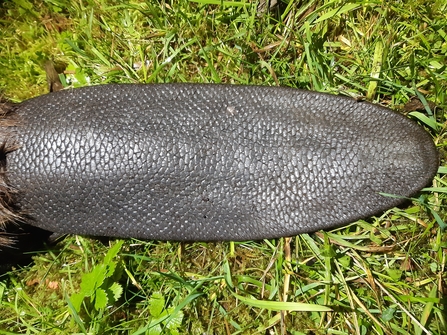
Beaver tail
One of the first things that probably comes to mind when you think of a beaver is one of their most unique and useful adaptations – their tails.
A beaver tail is hairless and scaly, almost like reptile skin and has a long paddle-like shape. The main use of a beaver’s tail is to help them swim by propelling them through the water and acts as a rudder to help them manoeuvre and dive. The scales provide protection against predators, help regulate the beaver’s body temperature and aid in maintaining buoyancy, allowing the beaver to effortlessly navigate through the water. Beavers also use their unique tails outside of the water to help them balance when reaching up high to access food, when they are grooming on the side of the riverbank or like in our footage in the last update, to balance whilst walking on their hind feet.
A beaver’s tail also acts as a fat store, enabling beavers to keep a layer of fat for when food is scarce, particularly in the winter. The size and shape of a beaver’s tail is a good indicator of how healthy they are. A beaver with prominent bones along its tail may not be receiving enough nutrients or may be in poor health.
Beavers use their tails as a means of communication. When frightened, a beaver will slap its tail hard on the water’s surface creating sound and movement to warn all the other beavers that there is potential danger nearby. Beavers also use a tail slap defensively to warn off or scare other animals, particularly those that could predate upon their kits.
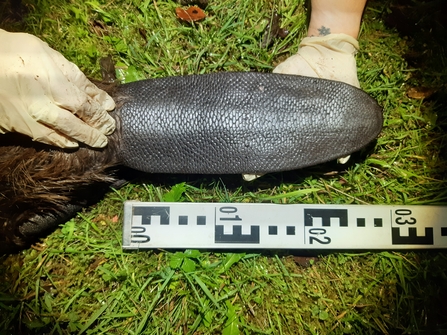
Beaver tail being measured
A beaver charging a polecat at the Dorset Beaver Project site. (https://youtu.be/cXtGnsWZqek)
Dorset Wildlife Trust / A beaver charging a polecat at the Dorset Beaver Project site.
Beaver tail slaps (https://youtu.be/AhPqpf7uiG8)
Compilation of beaver tail slaps at the Dorset Beaver Project site
Beaver tail slap reactions (https://youtu.be/ZUs55m9SGTE)
Tail slap reactions at the Dorset Beaver Project site
Summer wetlands
This summer we experienced severe warm, dry weather across the county, with many ponds, rivers and wetlands experiencing extremely low water levels or drying up completely.
At the Dorset Beaver Project wetland site, we were lucky to have no such problem. In fact, the water there has never been at such high levels!
Since the project began in 2020, we have been carrying out water surface area monitoring each year to study the effects the beavers are having on the hydrology and amount of water held in the landscape. This year has seen extremely dry, and hot drought conditions. Whilst across the county, and nationwide, we were seeing rivers at extremely low levels or completely dried up with many habitats facing wildfires and increased risk, yet our beaver wetland remained…wet!
The depth of the main pond on site has remained at an average of 8.1–8.2 metres throughout the summer months and, much to our amazement given the conditions, this year’s water surface area measurements revealed that the site is holding a record amount of water. Before the beavers were introduced, in 2020, the water surface area was approximately 3,319 m². Since their arrival in 2021, the water covering the site has more than tripled, now extending to 9,666 m². This measurement, taken in mid-August, is a fantastic example of how these ecosystem engineers not only create valuable wetland habitat but also provide an essential lifeline in hot, dry conditions, helping to make the landscape more resilient.
This is a remarkable record and highlights just how incredible these animals are at transforming wetlands and helping to retain water in the land during drought conditions, which we are likely to see more frequently as a result of climate change. It is hugely valuable to be able to study and promote the positive impact that beaver dams and wetland creation can have, not only on our site but also in slowing water and retaining it across the wider landscape for longer.
With beavers in the landscape, we may be able to face the future challenges of such hot dry weather with more resilience and hope.
The beaver wetland provides an essential lifeline for nature under the increasing threat of drought, with lots of wildlife making the most of the water the beavers have accumulated onsite. Just look at these kingfishers taking advantage of the watery oasis this summer.
Kingfishers at the Dorset Beaver Project site (https://youtu.be/l4HKacKXaXc)
Kingfishers at the Dorset Beaver Project site
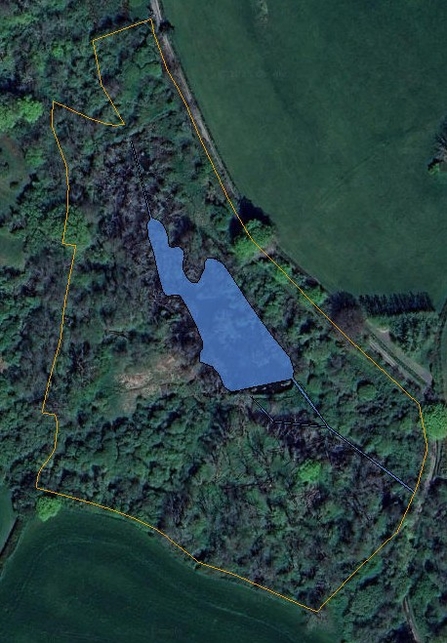
Water surface area of the Dorset Beaver Project site January 2021
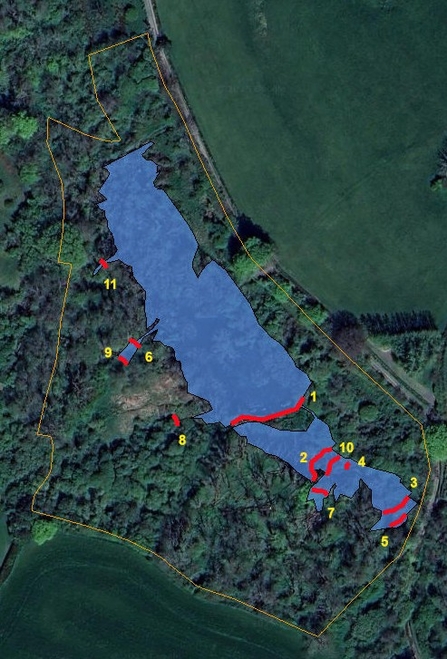
Surface water area of the Dorset Beaver Project site plus dam numbers August 2025
02.09.25 Walking beavers
Lodge maintenance
Male beaver maintaining the lodge (https://youtu.be/IPAy9nRsTVI)
Male beaver maintaining the lodge
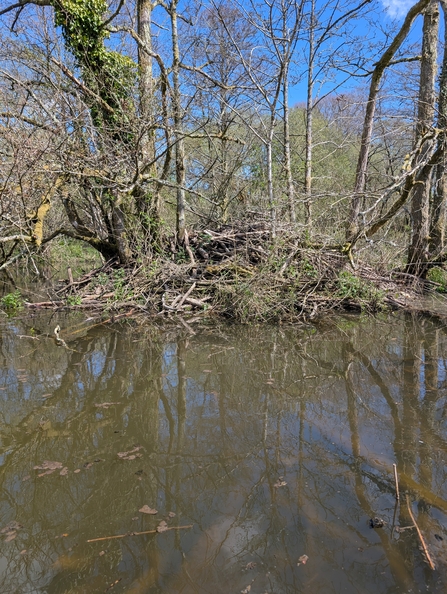
Hannah Divine / Beaver lodge at the Dorset Beaver Project site
We have been out on the boat once again to collect the trail camera we put out on the beaver lodge a few weeks ago and found some pretty unique footage!
Beaver lodges are the focal point and main dwelling of the beaver family, keeping them safe from predators and warm from the elements. Beaver lodges vary greatly in structure and size, depending on the size of the beaver family and the surrounding habitat. Lodges usually contain a submerged entrance tunnel, a feeding chamber at water level and a sleeping chamber above water level, but they may have more than one of each. Beavers always enter and leave their lodges through a submerged underwater entrance to enable them to keep safe from predators.
Some lodges are extremely obvious structures at the water's edge, whereas others consist of burrows and chambers with no obvious external features. The main beaver lodge at our site is a common island type lodge. This type of lodge is built on an island, constructed upwards, and contained within sticks and mud built above ground level like a roof, rather than a bank lodge that would be dug into the bank and often less obvious above ground. The lodge is made from mud, branches and vegetation. The water level remains fairly stable around the island location, reducing the chance of the beavers being flooded out.
We have captured a single beaver, (who we think could be the adult male from the breeding pair originally introduced to the site) carrying mud, silt, sticks and logs across different areas of the lodge and placing them down carefully. What is most exciting about this footage is the way in which the beaver is carrying the material. Though it is known that beavers can walk short distances on their hind legs, we have never captured footage of any of the beavers walking on their hind legs for this amount of time at our site. It is incredible how an often cumbersome and clumsy animal on land is able to use their long-webbed feet and flat tail to balance and highlights just how strong these animals are.
This is important lodge maintenance that the beavers carry out to keep the roof of their lodge intact. You can see in the clips above and below the beaver carefully manipulating the material into different areas, ensuring a secure built-up roof that offers protection and warmth, keeping the beaver family safe and secure.
Lodge maintenance predominantly takes place during the autumn months, but beavers can display increased lodge repairing and maintenance behaviour in spring if heavy rainfall washes away parts of the outer mud surface. Lodge building and maintenance behaviour can also be stimulated by pregnancy in the female and at this time of year lodge maintenance may be particularly important to keep newly born kits safe.
Beaver on the lodge during daylight (https://youtu.be/ZIoLF9nt94Y)
Beaver on the lodge at the Dorset Beaver Project site
Other wildlife using the lodge
Beaver lodges act as an important structure within an ecosystem, between land and water, utilised by a multitude of species. These piles of woody material provide foraging opportunities, warmth, shelter, and nesting material for other animals, particularly a variety of birds. We captured a number of species making use of the valuable habitat that the beaver lodge offers.
Species seen in the video by appearance:
- Canadian geese
- Male and female mallard
- Canadian geese
- Blackbird
- Female chaffinch
- Blackbird
- Wren dust bathing
- Eurasian jay
- Grey heron
- Mallard
- Emperor dragonfly and damselflies
- Grey heron
- Chiff chaff
- Juvenile moorhen
Different species spotted around the beaver lodge (https://youtu.be/HdX66oEtdmQ)
Different species spotted around the beaver lodge
Main beaver pond
On our journey to retrieve the trail camera we got to enjoy the beauty and serenity of the main pond. We had a lovely close-up view of the broad-leaved pond weed (Potamogeton natans), which is now in flower, spotted all sorts of aquatic insects such as water fleas, and damselflies, and were treated to a stunning show of clashing dragonflies. We were lucky enough to spot a male emperor dragonfly defending its territory from a brown hawker dragonfly – a species we have never recorded at this site. As well as this we also witnessed a female emperor dragonfly laying eggs. Studies have shown that beaver territories have significantly more dragonflies and damselflies than areas without beavers.
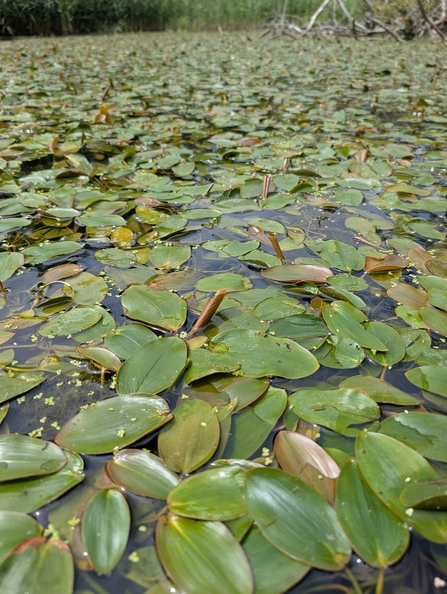
Damselfly on broad-leaved pond weed at the Dorset Beaver Project site
15.07.25 Breeding beavers?
We have captured a couple of shots of our adult female beaver in recent weeks with prominent nipples – a sign she is either pregnant or nursing kits! Beaver kits are born around May/June and spend the first few weeks inside their lodge before emerging for the first time in late June/July. We will be keeping an eye out for some new kits in the next few weeks and will keep you updated!
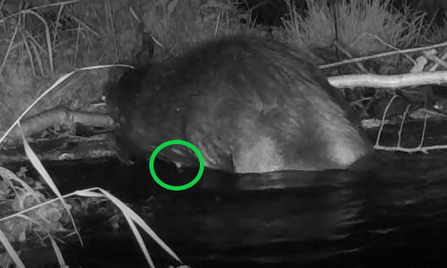
Female beaver with prominent nipples
Beavers in the daylight
Now that the days are longer, and beavers have less time to do their necessary foraging under the cover of darkness, we have been catching lots of clips of the beavers in the daylight hours. It’s lovely to see them a bit more clearly and have a chance to appreciate their charismatic faces and chestnut brown fur. Here’s a peek at the beavers going about their business in the sunshine. If you look closely at the last clip, you will notice a bubble trail in the water as the beaver swims underwater out to the main pond – a key sign to look out for when looking for beavers beneath the surface!
Hands and feet
When looking at the adaptations that beavers have, their paws are probably not the first things you would think of. In fact, beaver's hind and fore feet are highly specialized and adapted to help them thrive in their watery environments. Firstly, a beaver's front and rear feet are noticeably different, they also use them in very different ways.
A beaver’s fore paws are used for manipulating objects such as carrying twigs, and rocks and digging. They are fairly small and handlike. They have five toes on both their fore and hind feet but on their front paws they have a semi opposable little finger, instead of a thumb that we humans have, making them highly adapted to manipulating and lifting objects, important for feeding, digging and building their lodges and dams.
A beaver's hind feet are much longer than their smaller front feet and are less dexterous. The main use of their hind feet is to aid in swimming. Their hind feet have almost no hair on them to minimize water resistance and are webbed to help them maneuver and propel through the water. They do not use their hind feet to hold or interact with objects, instead they are designed to help with movement, only their back feet are webbed, allowing for a greater range of movement in their fore feet to help them pick up objects. Beavers tend to keep their front feet tucked up when swimming rather than using them to paddle.
Beavers have claws on both their front and rear feet, but these are generally sharper and more pointed on their front feet to help with digging and grooming. As mentioned previously, beaver's claws are further adapted to help with grooming their important fur with a unique ‘split nail’ claw which helps remove dirt and spread oily ‘castoreum’ to help keep their fur waterproof.
Coppicing regrowth
This time of year is a great time to highlight the coppicing work that the beavers carry out through their natural foraging behaviour. As the beavers fell trees such as willow, rather than killing the tree, they bring and encourage new life and build dynamic habitats with a variety of features. The stump of the foraged tree begins producing numerous shoots in the spring following being coppiced by the beavers. This regrowth overtime creates an abundance of food, cover and nesting places for herbivorous and small mammals such as voles and dormice, and a wide variety of invertebrates and birds.
This coppicing also enables the tree to live a healthier and longer life with more opportunity for growth through its multiple shoots. Felling the trees also creates space for light to reach the ground, encouraging a flush of new ground flora species that cannot thrive in shade to grow. This is a key stage in natural processes as part of the succession that takes place in natural, healthy ecosystems – the changing dynamics of the habitat over time and allowing for a cycle of different species to develop and exist. Willow, and other tree species growing in or near water, have evolved alongside beavers for millions of years and it may be due to this tree foraging by beavers that has given rise to them reacting in such a way when felled.
People have long understood the benefits of coppicing; it is an old traditional practice that still happens today in order to provide woody materials for human use, as well as its benefits for biodiversity. This is just another way that beavers have positive effects on the environment around them that may also save us humans some work!
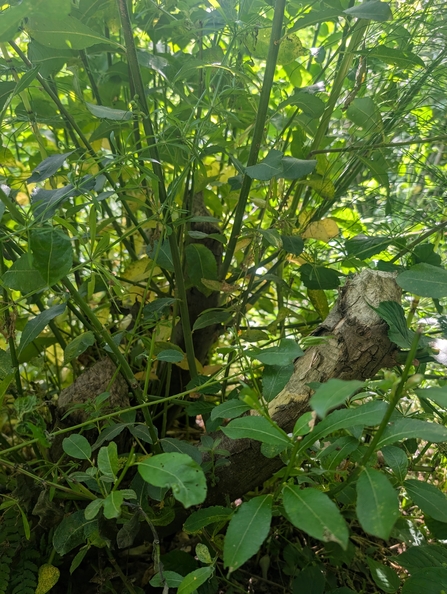
Hannah Divine / Coppiced willow regrowth at the Dorset Beaver Project site
Sights and sounds of a beaver wetland
We'd like to end this latest update with a moment of mindfulness. We have put together a compilation of clips from the beaver site collected throughout the spring for you to enjoy.
Sights and sounds from a beaver wetland (https://youtu.be/6Zb1EQT9q0s)
Sights and sounds from a beaver wetland
17.06.25 Dam building
The water surface area at the Dorset Beaver Project site has more than tripled since the beavers arrived in 2021, highlighting their impressive ability to create wetlands. The beavers have kept us very busy recently with their efforts to retain even more water on site, meticulously extending one of their dams at the lower end of the area.
We normally allow the beavers to carry out their natural behaviour without interference, including dam building. However, they’re currently extending a dam towards the outer enclosure fence, causing water to pool and submerge part of it. As part of our licence to operate an enclosed beaver project, we must maintain the integrity of the fencing to ensure the beavers remain safely on site. Submerged fencing is harder to monitor, risks damage, and prevents us from spotting and repairing any holes or weaknesses. We're closely monitoring the dam in this area and may need to make minor, careful adjustments—or remove the new extensions—to protect the fence and meet our licence conditions.
Great care is taken to ensure any interventions do not negatively impact the beavers. For our team, this is also a valuable learning experience in managing future interventions—something that may occasionally be necessary as these industrious mammals return to the wider landscape through controlled reintroduction in England. All staff involved in beaver management, including at our enclosed site, have received appropriate training and hold the necessary licences to intervene when a dam causes problems. In the UK, no licence is required to remove a beaver dam that is less than two weeks old.
The beavers have been busy attempting to extend their dam to the fence several times between our weekly site visits. We set up a camera to capture them in action and managed to film the dam being built from start to finish. We’ve put together a few clips—sped up slightly in the middle—so you can watch the full construction process. In the video, you’ll see the beavers start by pushing up mud and silt and placing large rocks to form a base. They then drag branches and woody material of various sizes, layering them precisely to create an intricate, functional dam. Mud, silt, and rocks are added throughout to strengthen the structure. As the dam takes shape, more water is retained. The water spreads closer to the fence, and as the level rises, the beavers become more submerged—eventually diving once the water is deep enough!
On this occasion, we captured at least three members of the beaver family working together to build the dam. Over six nights, they spent nearly 15 hours constructing it—pausing now and then for snacks and a bit of grooming. Since the footage was recorded, the beavers have been deterred and appear to have turned their attention to other activities in their wetland home. However, our team is keeping a close eye on this spot in case they decide to continue their dam-building efforts.
Beaver dam creation (https://youtu.be/Ueu0ahczpeU)
Dorset Wildlife Trust
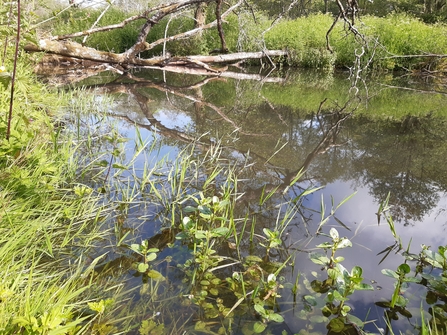
Hannah Divine / Plants colonising new shallow, marginal waters
Newt expansion
As part of our amphibian monitoring, we've recently found that newts have expanded their breeding range into several new ponds within the beaver wetland.
Female newts lay their eggs on the leaves of aquatic plants in shallow pond margins, carefully folding the leaves to hide them. Since the beavers arrived, the wetland habitat has grown and improved, creating more suitable vegetation for breeding. As a result, newt eggs are now being recorded across a wider area.
These are brilliant signs—and yet another example of how beavers’ ecosystem engineering is benefiting other species.
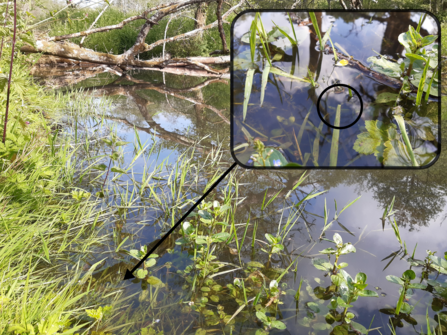
Hannah Divine / Newt eggs on a leaf at the Dorset Beaver Project site
Feathered friends
In spring, the beaver-modified wetland provides ideal breeding habitat for water-loving birds like mallards and moorhens. The increased aquatic vegetation and invertebrate life offer plenty of food, while the dense habitat gives their nests and young the cover they need to stay safe.
Over the past few weeks, we’ve captured plenty of footage of these feathered youngsters and wanted to share a few clips of our adorable new residents.
Mallard ducklings and moorhen chicks (https://youtu.be/9nlbuc84QiE)
Dorset Wildlife Trust
15.05.25 New life on site
The beavers
The beavers have been captured on our cameras indulging in a lot of mutual grooming in the last couple of weeks. This behaviour is really important to strengthen their family bonds and maintain their thick fur, which is extremely important to them and one of the many adaptations' beavers have that make them so well suited to their watery home environment. The beavers can be seen here in one of their favourite spots where they feel safe grooming together as a family. It is obviously a good spot for grooming as the mallards have been seen enjoying it for the very same thing!
Beaver fur
An important adaptation that beavers have which makes them suited to their aquatic habitat is their dense, thick fur, which is incredibly important to keep them warm and dry in their wet and often cold environment. A beaver’s fur is made up of two layers; a softer dense underfur which traps air against the beaver’s skin to keep them warm and longer darker guard hairs that are stiffer and more protective and help to keep water away from the softer fur underneath. The fine hairs in the undercoat also have tiny hooks on them which can bind together, enmeshing and forming a barrier that helps to keep more water out. Beavers further enhance their fur by making their coats waterproof by covering the hairs in a layer of ‘castoreum’ (an oily secretion from their castor glands which they use during scent communication) which stops the water from passing through to the skin. A beaver’s fur acts almost like a wetsuit for the beaver and enable them to live happily in and around water.
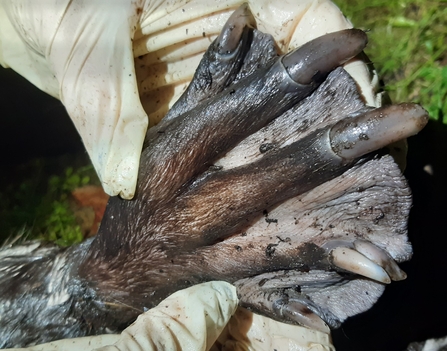
Steve Oliver / Beaver split grooming claw
Beavers maintain the ‘castoreum’ layer of their fur during grooming, and they have another adaptation to help with this – a specialized split nail ‘grooming claw’ on the second toe of each of their hind feet, which they use to remove dirt and comb oil into the hairs all over their bodies.
Unfortunately, it was their fur that made them a target in the past that led to their extinction in the UK. A beaver’s fur was highly sought after by humans due to the amazing thickness and warmth it offers.
Wild visitors
The wetland site is not only home to beavers, but a variety of other species which have increased since the beavers arrived, making use of the habitat they have created. We have spotted a fox regularly, who we think may have moved in, otters, and roe deer crossing the main beaver dam. We have also had some Canadian geese swimming serenely on the largest of the beaver ponds and spotted a brand-new resident – a mallard duckling.
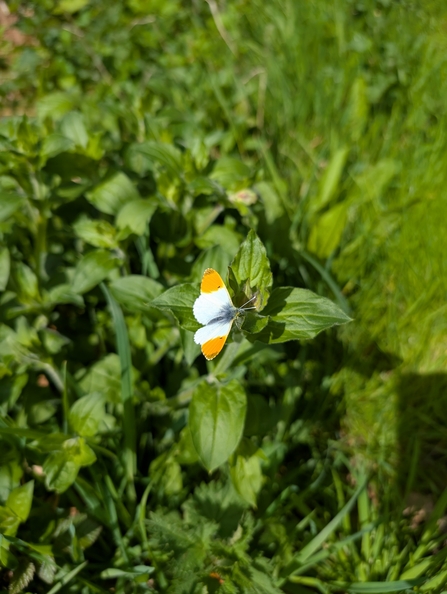
Hannah Divine / Orange-tip at the Dorset Beaver Project site
With the warm, dry spring weather the site has become a butterfly hotspot, and we have recorded brimstone, peacock and orange-tip butterflies.
The orange-tip butterflies may be particularly happy in the beaver created wetland due to the numerous cuckoo flowers that have sprung up and gradually increased over the last few years as the damp habitat they thrive in has become larger due to the beaver's habitat modifications. The cuckoo flower is the food source of the orange-tip butterfly, and where they lay their eggs. We spotted some tiny bright orange dots underneath the flowers, which are orange-tip butterfly eggs. Once hatched the caterpillars will feed on the cuckoo flowers before they go on to become butterflies. We will be keeping an eye on the plants and will hopefully be able to show you some orange-tip caterpillars in the next few weeks.
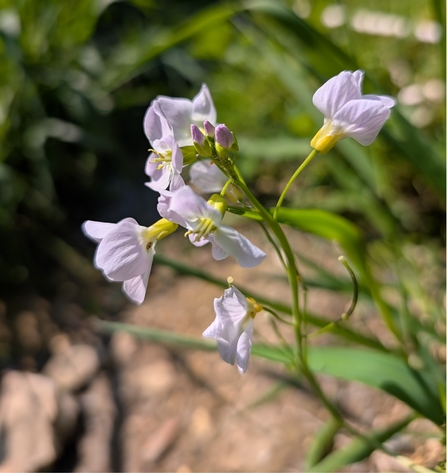
Hannah Divine / Cuckoo flower with orange-tip egg
As well as cuckoo flowers a variety of other wildflowers have created scatterings of colour across the site and can be seen across the wetland and wet woodland floor at the moment. These include carpets of bluebells, mixed with wood anemone, greater celandine, purple violet, yellow pimpernel, carpet bugle, and marsh marigold.
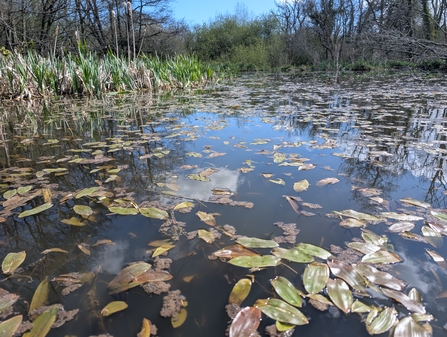
On the pond
Our rivers team headed out onto the main pond for a dinghy side view of the beaver lodge. We had a look around at the reeds and vegetation and got some great shots of the main beaver lodge from the water. The beavers do a great job of managing the reeds, by pulling them up and eating the roots. The reeds can dominate if not managed, and by doing this the beavers are carrying out a job that is often part of wetland habitat management for conservationists and land managers. The broad-leaved pond weed has risen to the surface and in the next few weeks will layer the surface of the water and come into flower in the summer months. Broad-leaved pond weed is great for providing shade to the water below and reducing the growth of algae. Its leaves also act as platforms for viewing, courting and mating for a variety of insects. Whilst out on the water the team secured a trail camera to a tree near to the lodge. We will hopefully share any footage we gather from the new camera in a few weeks' time.
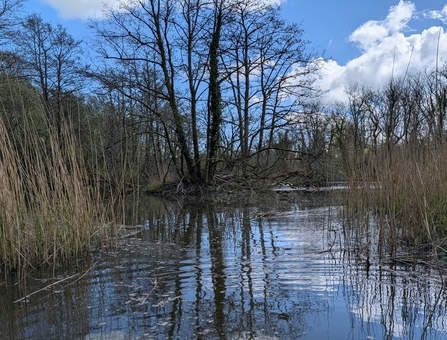
Hannah Divine / Beaver lodge through the reeds
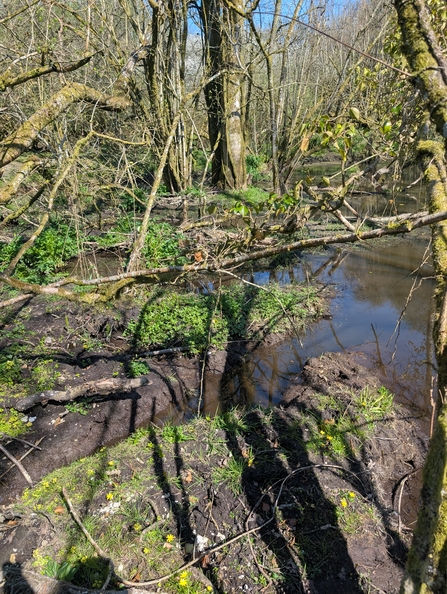
New beaver channels
There has also been some recent channeling carried out by the beavers. Creating channels is one way in which the beavers modify the environment and create dynamic habitats. Channels such as these spread and diversify the flow of water and create fantastic habitat for a variety of wildlife, particularly water voles. In straightened modified rivers, water voles are severely under threat from predation from species such as the invasive, non-native American mink as they can swim up and down a straight narrow river and pick off water vole easily. In a more dynamic and varied beaver wetland, these channels create essential hiding places for water voles and make it harder for predators such as mink to get to them, greatly reducing their rate of predation. More beavers = more water voles!
30.4.25 Spring's in full swing
Spring has officially sprung at our enclosed beaver site and the site is once again coming to life. Throughout the spring and summer, our beavers will be more active during daylight hours, will change their diet to include the abundance of vegetation shooting up, and we may get to see signs of breeding. And it’s not just the beavers that are busy this spring, lots of other species are thriving in our beaver wetland at this time of year.
The beavers
The beavers are as busy as ever this spring and have been spotted on our cameras across the site carrying out a variety of their favourite pastimes. We were lucky enough to have a lovely close-up of one of our beavers inspecting our trail camera. As well as the usual grooming and transporting and gnawing of sticks and branches, the beavers have been tucking into the new spring vegetation. They are still eating the cambium layer (outer bark) of branches, but now have the added nutrients and variety of food sources from the spring growth including leaves, buds, and various plants across the ponds and water’s edge.
Beaver sniffing the trail cam (https://youtu.be/RVXrY-87Stk)
Beaver sniffing the trail cam
Beaver behaviour (https://youtu.be/QXo1xzh1aKs)
Beaver behaviours
Hannah Divine / Frogspawn clumps at the Dorset Beaver Project site
Amphibians emerging
At the start of spring, we carried out our annual frogspawn surveys and mapped where we found spawn across the site. The abundance and spread of frog spawn has been increasing year-on-year at the site, and this year we have for the first time found frog spawn in a new, entirely beaver-created pond, one that did not exist prior to the beaver's arrival and where no frogspawn had been recorded previously. The beavers seem to have slowly created and expanded the ideal habitat for frogs to breed since their arrival in 2021. The spawn is progressing nicely in the warm weather and the water is now buzzing with movement from the clumps of tiny tadpoles wiggling around. We also carried out refugia surveys (where an artificial refuge such as a corrugated tin or felt mat is placed in suitable habitat to attract reptiles), beginning in April, and during our pre-survey checks encountered a smooth newt sheltering under one of the refugia, which was great to see.
Hannah Divine / Smooth newt at the Dorset Beaver Project site
New species visiting the site
We have also had a new bird visitor to the site – the cormorant. These aquatic birds have been seen on nearby rivers but have never been recorded on site until now. As they are almost always found around coasts, rivers and lakes, and have a diet made up almost entirely of fish, having these birds on site is amazing news and suggests that the beaver created habitat is becoming a thriving wetland capable of supporting such specialist aquatic-based species. The presence of cormorants indicates that there is an abundance of fish for them to prey upon, while the complex habitat created by beavers provides ample hiding places for fish. This suggests a balanced predator-prey interaction and a healthy, dynamic ecosystem.
Cormorant at the Dorset Beaver Project site (https://youtu.be/GNV1ZQ4lKDc)
Cormorant at the Dorset Beaver Project site
9.4.25 Beaver teeth
Beaver teeth at night (https://youtu.be/IoDF8IzMOaA)
Footage showcasing a beaver's teeth and its tree gnawing capabilities at the Dorset Beaver Project site.
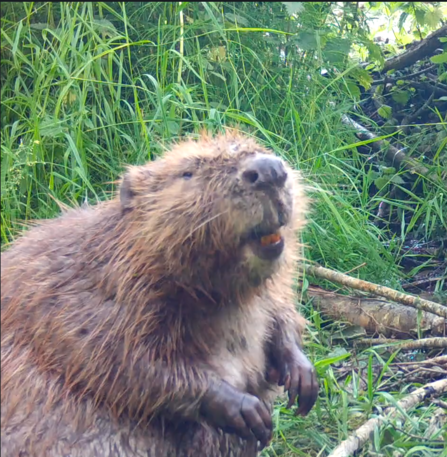
Hannah Divine / A beaver showing its teeth at the Dorset Beaver Project site
This week we are starting with something most rodents are well known for, and which are especially important for beavers - their teeth!
Beavers have twenty teeth in total, including four large incisors at the front. A beaver’s teeth are unique in the animal kingdom due to one obvious feature – their colour. A beaver’s teeth are a rusty orange colour due to the high iron levels in the tooth's structure, giving them particularly tough enamel, making them exceptionally strong and durable. In fact, beaver teeth are made mainly of two components – iron and dentine. This structure also gives the beavers another advantage for munching on wood. The dentine is found at the back of the teeth, with the iron at the front. This dentine is softer than the iron front and therefore wears down quicker. This gives beavers' teeth their distinctive and extremely effective chisel-like sharp cutting edge.
Having so much iron in their teeth also makes them resistant against tooth decay – which is vital to beavers given how much they use their teeth. These adaptations give beavers teeth which are unrivalled in shape and strength, just what’s needed when you're chewing on wood all day. Beavers' teeth, like other rodents, are continuously growing so they need to gnaw on wood to keep them the right length and in good condition.
Did you know? A beaver can fell an eight-foot tree in just five minutes!
Beaver teeth - daytime clip (https://youtu.be/43x8a60_DbU)
Footage of a beaver at the Dorset Beaver Project site.
Sign up for beaver updates
Support the Dorset Beaver Project
Watch more of our beavers in action
More about the Dorset Beaver Project
On 8 February 2021, following years of preparation, a pair of beavers (an adult male and female) were released into an enclosed site in west Dorset, having been relocated from Scotland under licence from NatureScot. Since then, the pair have settled well into their new home, having multiple generations of kits, transforming the project site into a wonderful wetland world.
This is a scientific study site and in partnership with the University of Exeter and Wessex Water, we are gathering information on biodiversity and hydrology (water quality and flow) and studying the behaviour and activities of the beavers. We will be making comparisons to the baseline data gathered before they arrived to see how beavers can improve the habitat they occupy and the wider benefits they can potentially bring to the environment in terms of biodiversity, water quality and beneficial effects on river catchments.
Throughout the project, animal welfare has been an absolute priority, so we have ensured that the 4-hectare enclosed site offers enough complex habitat to support the newly expanded beaver family.
Beaver kits
Beaver kit falling off a willow tree. (https://youtu.be/KYIe7Ky31MY)
Steve Oliver / One of the new beaver kits falling off a willow tree whilst trying to feed.
Second generation beaver kit feeding on willow (https://youtu.be/s9DO2Tqtq_Q)
Colleen Smith-Moore / New beaver kit feeding on willow branches in the Dorset Beaver Project site.
First beaver kit born in Dorset (https://youtu.be/8DoqKsoc6RE)
Dorset Wildlife Trust
Beaver dams
Adult beaver caching wood (https://youtu.be/uo5F6hxtxlI)
Adult beaver at the Dorset Beaver Project site caching wood
Beaver maintaining its dam (https://www.youtube.com/watch?v=u7bMlAlSgNw)
Dorset Wildlife Trust / Beaver maintaining its dam
Beavers and other wildlife
Moorhen family and grey heron enjoying the beaver-created wetland. (https://youtu.be/9DkTiBitnRg)
Steve Oliver / Moorhen family and grey heron enjoying the beaver-created wetland.
A beaver charging a polecat at the Dorset Beaver Project site. (https://youtu.be/cXtGnsWZqek)
Dorset Wildlife Trust / A beaver charging a polecat at the Dorset Beaver Project site.
Dorset Wildlife Trust / An otter interacting with two beavers at the Dorset Beaver Project site.
Dorset Wildlife Trust / Weasel family playing in the beaver dam at the Dorset Beaver Project site.
Dorset Beaver Project site video tour
Dorset Beaver Project site video tour (https://youtu.be/MdEJawbJ36A)
Video tour of the Dorset Beaver Project site
Online talk: Dorset Beaver Project with Steve Oliver
Online talk: Dorset Beaver Project (https://youtu.be/lBiQMKCi7cU)
Online talk: Dorset Beaver Project. By Steve Oliver, 29.01.25

